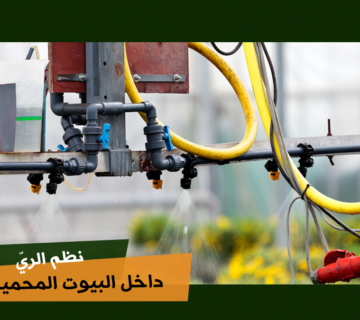There are many irrigation systems used in agriculture, whether protected or traditional, and they are responsible for transferring irrigation water from its sources to plants, depending on an existing network of pipes, whether above or under the soil, and drip irrigation is one of the most famous and widely used irrigation systems in The protected houses; Because of its many features, which we will explain and more in this article..
قائمة المحتوى
Drip Irrigation System
- It is a system that transfers water to plants slowly and repeatedly, in the form of successive drops.
- These drops fall through drippers that are installed on the water supply lines parallel to the cultivation lines inside the greenhouse.
- The discharge of a single dripper ranges between 15:2 liters per hour, and the discharge of some drippers may reach more than that.
Learn about other greenhouse irrigation systems
Features of the drip irrigation system
This system provides a set of features, the most important of which are:
- It contributes to controlling the quantities of water and fertilizer used, thus increasing productivity.
- Reduces the growth of weeds and weeds that may harm the plant.
- The drip irrigation system allows chemical fertilization to be carried out.
- It also helps in regulating the irrigation process and saving water consumption.
Drip Irrigation System Components
Console
This unit, in turn, consists of a set of elements, namely:
Pump
Which draws water and then raises it and pumps it, and the pumps derive their power from an electric motor or an internal combustion engine located in it.
Filters
These filters may be sand or paper, and in all cases, they play an important role in preventing clogging of the drippers, and thus homogenizing the process of water distribution to plants.
Valves (pressure regulators)
The function of these valves is to control the drain or regulate the water pressure, and these regulators are often placed at the beginning of each control unit, as well as inside the main and branch pipes.
Compost bed
through which the fertilizer is pushed into the irrigation network, using another pump or a fertilizer.
Pipe Network
- The drip irrigation system includes a group of main, branch and field tubes, which are usually made of ethylene.
- Its diameter ranges between 20:10 mm, and its length ranges between 150:40 cm.
- It is also equipped with drippers, the distances between which vary according to the type of crops to be irrigated.
Difference between drip and sprinkler irrigation
Drip irrigation problem
- The problems with this system are usually few and limited, but there is one problem that some farmers usually face, which is the blockage of the drippers used in the irrigation process.
- This blockage may occur as a result of the deposition of impurities and dirt inside the irrigation water.
- So; It is important to pay attention to the installation of filters, as they play a major role in preventing these impurities from reaching the droplets.
- And in case you want to clean your irrigation system; You can use many materials; Such as phosphoric acid, which contributes to the dissolution of precipitation.
Because the drip irrigation system works to wet the roots of plants only, it prevents them from contracting any diseases that may result from contact with water, unlike other irrigation methods such as sprinkler irrigation, and therefore this system is more efficient and effective than others.

 then 'Add to home screen'
then 'Add to home screen' then 'Add to home screen'
then 'Add to home screen'


لا يوجد تعليقات